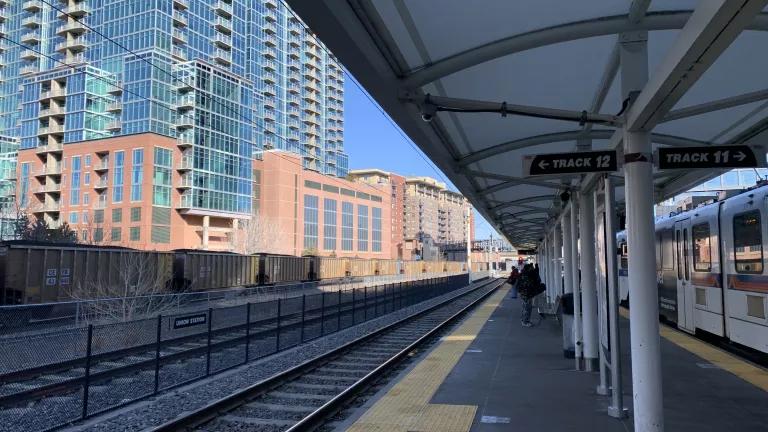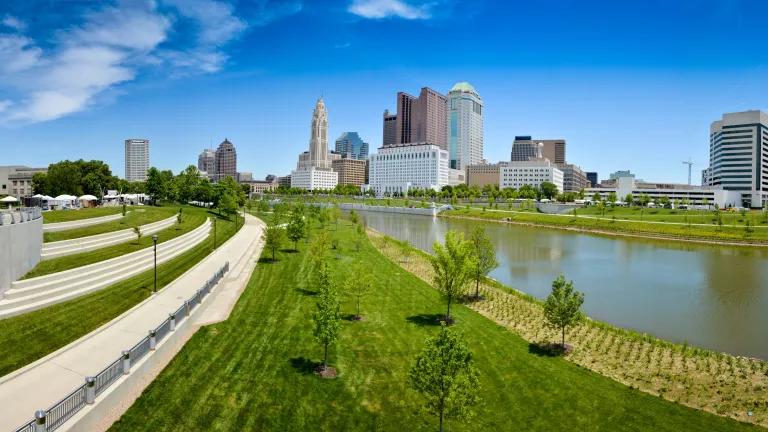Disruption and Unity: Cities Stand Strong on Climate in 2016

As we close out 2016 and prepare for the challenges of an incoming administration, many are worried that progress in combating climate change and working toward a society where all can prosper could stall.
But there are reasons to remain hopeful. One of those is the potential for progress at the local level—in our states, and in our cities. To get there, we must start by tackling the inequality that stubbornly remains in urban areas nationwide.
It plays out this way: When you say, for example, that you reside in Philadelphia, Atlanta, Los Angeles, Des Moines or New York, you may describe your city very differently from someone who lives in a different neighborhood in the same metropolitan area.
How you experience your city depends on what language you speak at home, your income level, your race, and even your age because those things often determine whether your neighborhood has trees for shade and storm water drainage, air without high levels of vehicle exhaust and manufacturing pollution, quiet streets away from congested freeways, energy-efficient construction, and access to quality education, public transportation and stores with healthy food.
It’s not necessarily the case that our zoning laws, housing rules and planning efforts are meant to exclude people from the basics of life like clean air and water, but they often do, and that’s true of cities nationwide.
Quantifying the American Dream
These factors of exclusion also go to the heart of something even bigger, and perhaps uniquely ours—that is, how likely people are to achieve the major aspirations of the American Dream, most notably that hard work, growth and prosperity will mean that their children will do better than they do.
New research has shown that the odds of escaping poverty in the United States vary vastly by region, and now, an “American Dream index” reveals that the rise of American inequality means that babies born in the 1980s have only a 50 percent chance of making as much or more money as their parents did – compared to 92 percent of those born in 1940.
Other research has found that while some of the problem is because of a decline in growth overall, inequality of growth is a much bigger issue, with dramatic differences among income classes preventing an increase in living standards for the middle class and the poor.
This inequality is fueled by federal economic policies that appear likely to continue under the new administration in Washington but it also exists at a time of broad-based disruptions in global economics, corporate organization, labor and demographic shifts—the latter including the exploding growth of cities and urban innovation hubs.
It is there, in cities, where we can try to reimagine the system that furthers these systemic inequities, all of which are closely tied to the environment, and create a vision that is inclusive and sustainable in which everyone, not just those in certain neighborhoods, thrive and prosper. Local empowerment is the future.
We believe strongly in the power and importance of cities as evidenced by our work in 2016 and our focus as we face new stakes in 2017 with an incoming administration that has talked about rolling back environmental protections.
Global Mayors United
It was my privilege to attend the C40 Mayors Summit in Mexico City at year’s end and I learned just how committed to addressing climate change our localities are. This followed a year of action by cities in continuing to claim their leadership in this arena while national governments debate—in some cases, even the existence of climate change.
That action included a rise of 70 percent in the number of cities internationally that are reporting on their climate efforts since the Paris Climate Agreement of last year, with four in 10 cities measuring their emissions compared to one in 10 in 2011. And thousands of cities in 119 countries have come together under one umbrella—the Global Covenant of Mayors for Climate and Energy, described as the largest global coalition of cities committed to climate leadership.
As I’ve said before, mayors get it—and there was even more evidence of that based on their statements in Mexico City.
“We don’t have to choose social goals, or quality of life goals, or environment goals,” Bogota Mayor Enrique Penalosa said in a video released during the summit. “They are the same.”
“If we don’t include the whole population, we won’t manage to solve the climate challenge,” said Paris Mayor Anne Hidalgo.
“Part of the urgency of this issue is cities are leading,” added Portland Mayor Charlie Hales. “Cities are leading on climate but they’re also leading on these issues of income inequality. If there is a way to combine social equity with environmental responsibility, that is powerful.”
The Two E’s—Environment and Equity
That nexus is where Urban Solutions focuses as a program, as evidenced by our work during this rewarding and unpredictable year.
Among that work was the recent announcement that the City Energy Project, which we co-lead with the Institute for Market Transformation, would expand to include 10 more urban areas in its group of 20 cities working to reduce energy waste in large buildings. That comes a year after funding for the expansion was announced at the Paris Climate conference. Policies and programs in these next 10 cities will cover both commercial and multifamily properties while piloting some innovative approaches for underserved markets.
Most recently, in Los Angeles, CEP supported the city’s goals in responding to this shocking statistic: Half the city’s electricity demand comes from just 4 percent of its buildings. The city in early December passed the most comprehensive building efficiency policy among big cities in the nation—the Existing Building Energy and Water Efficiency ordinance—affecting most city-owned buildings of 7,500 square feet or more and privately owned buildings of at least 20,000 square feet.
All told, when the policies and programs are fully implemented in all 20 cities, they will save nearly $1.7 billion in energy costs and avoid more than 9.6 million metric tons of carbon that would have polluted the air.
Relatedly, our Energy Efficiency for All program is ensuring with our partners and stakeholders that low-income families reap all the health and economic benefits from energy efficiency. Most recently, in California, we achieved a significant victory when the public utility commission adopted major improvements to its low income energy efficiency program, allocating $80 million toward rent-assisted multi-family housing, among other enhancements—the culmination of years of effort. To date, we have helped secure over $250 million in funding to improve multifamily homes in seven states, demonstrating the benefits of EEFA’s collaborative partnerships between the affordable housing and environmental sectors, and the critical importance of on-the-ground coalition-building efforts.
Stronger Futures at the Community Level
The year 2016 also saw the launch of the Strong, Prosperous and Resilient Communities Challenge (SPARCC), which over the course of three years will invest $20 million in grants and deploy some $70 million in at least six regions to address the disparity in our quality of life. The dynamic coalition behind SPARCC includes NRDC’s Urban Solutions, which I lead, Enterprise Community Partners, the Low Income Investment Fund and the Federal Reserve Bank of San Francisco—with support from the Ford Foundation, The Kresge Foundation, and the Robert Wood Johnson Foundation. Our fiercely held aim is to shape the places in which we live in ways that tie racial equity, health and mitigating the effects of climate change together.
Another cross disciplinary group this year launched the first in a series of reports—called Taking the High Road to More and Better Infrastructure in the United States—that helps cities and regions tackle our most pressing 21st century infrastructure problems. High Road Infrastructure – a concept we developed—is a holistic approach that demonstrates how taking the High Road helps create consensus among government, citizens and investors by ensuring infrastructure investments reflect the long-term needs of the communities they are meant to serve. It’s the type of infrastructure that can create and provide access to quality jobs, lower carbon emissions, improve public health, and provide a line of defense to the effects of climate change with resilient streets, sidewalks, water systems, bridges and public spaces.
We also helped spearhead the new global Green Bank Network in support of the creation of new public institutions called Green Banks as a way to help mobilize private capital and speed up the “big switch” internationally toward clean energy. In the United States alone, Green Banks in New York, California, Connecticut, Hawaii and Rhode Island have the potential to unleash billions of dollars in private cash needed to bring about a clean energy economy and successfully combat the serious threat of climate change.
For the second year, we held our Live.Ride.Share Conference, this time in Denver, bringing together a coalition of local and national transportation, business, environmental and advocacy organizations, as well as community, political and activist leaders on the rapidly growing, technology-driven trends and policies in transportation. The conference highlighted Denver’s status as a new-mobility transportation leader but went far beyond—to reveal the latest developments in innovative transportation solutions, ranging from new types of “smart” car pools to driverless vehicles, and discuss how they can transform cities, improve public health, and promote opportunity.
Throughout the year, we have studied, advocated and weighed in on issues ranging from the continuing climate-related floods plaguing our coastlines and hurting poor families disproportionately, to the Department of Transportation’s top priorities for reducing greenhouse gas emissions, the race to make our cities smarter and the massive food waste in America.
We have been lifted up and inspired to hear city leaders in this country and in others around the world talk openly this year about the necessity of addressing climate change to expand opportunity for people of all backgrounds and incomes—and act accordingly.
We come away from 2016 with a profound sense of urgency and commitment to respond to what the American people overwhelmingly say they want—action on climate, the environment, clean-energy jobs, better health, a more fair and equitable society and, most of all, more opportunity for our children.
Address inequality at all levels in the coming challenging year, and perhaps the American Dream will become attainable for the majority of Americans once again.




